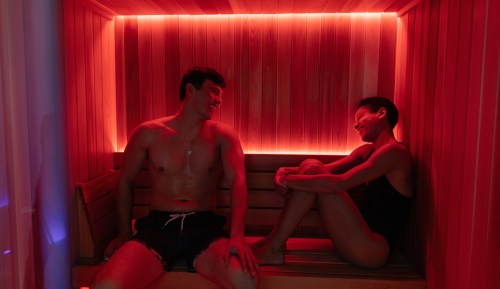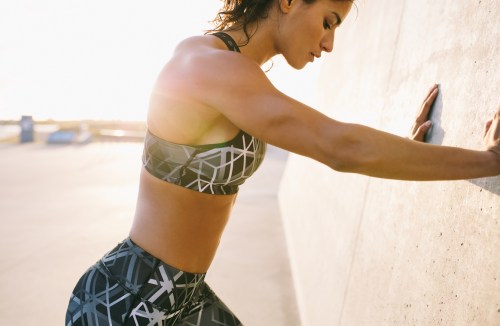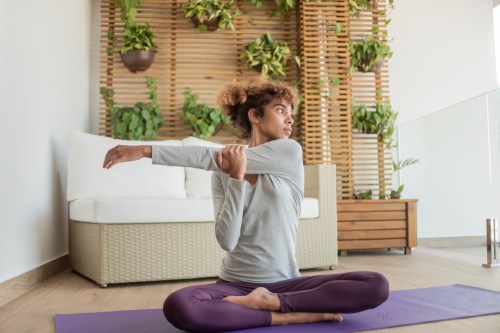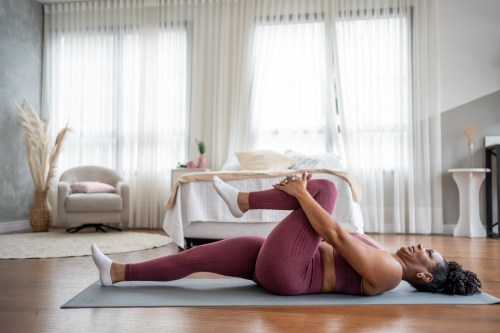The Only 7 Leg Stretches You Need to Banish Stiffness and Improve Flexibility
Try these 7 leg stretches for better flexibility and less stiffness and pain, and discover more benefits of effective lower-body stretching.
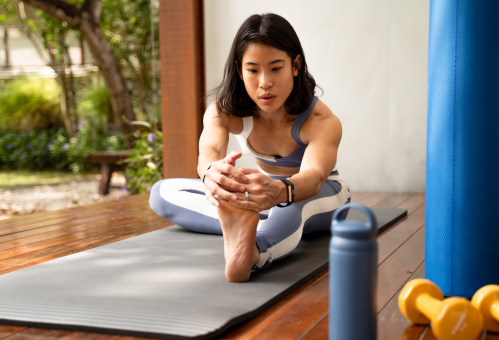
Stretching isn’t exactly the most glamorous or exciting part of anyone’s fitness routine, but it is an important part. To maximize the time you spend getting long and loose, you want to do effective stretches that will make an impact on your workouts and your life—that’s where leg stretches come in. We’ve done the leg work (pun intended!) and narrowed it down to the seven best stretches to improve your lower body flexibility.
Experts in This Article
corrective exercise specialist and founder of Garage Gym Greatness
trainer and human performance specialist with Memorial Hermann’s Rockets Sports Medicine Institute
Everyone can benefit from improving their flexibility, but neglecting your lower body is a great way to invite pain and stiffness into your life. One of the most obvious signs that tight muscles could be causing issues, says Andrew Peak, CPT, corrective exercise specialist and founder of Garage Gym Greatness, is difficulty doing everyday activities due to stiffness, such as squatting down or picking items off of the floor.
“Tight leg muscles can also lead to poor posture and alignment, which is often noticeable during standing or walking,” he says. This can lead to hip, knee, and lower back pain.
Another sign of reduced flexibility? “Recurring discomfort or stiffness in the legs, especially after periods of inactivity or following exercise,” he says.
You don’t need to make stretching your top fitness priority, but you do need to stretch regularly—particularly your lower body—to reap the benefits. If you want to really boost your flexibility, you can stretch every day to see the fastest improvement. But at minimum, the American College of Sports Medicine says you should stretch at least two to three days per week.
6 stretching benefits
These are just some of the expert-backed reasons you should add the below leg stretches to your fitness routine.
1. Improves range of motion and flexibility
A regular stretching routine helps your body move with ease. “Stretching helps keep the muscles more flexible and maintains the normal range of motion in the joint which is essential for daily functional activity,” says Karly Mendez, human performance specialist with Memorial Hermann’s Rockets Sports Medicine Institute.
2. Improves athletic performance and reduces injuries
Research1 has found that stretching can improve your muscle strength and agility, as well as prevent injuries. A joint with full range of motion functions like it should—which means the muscles are stronger and healthier. For best results, experts say to perform dynamic stretching (active stretches that take your joint through the full range of motion) before athletic activities, and passive stretching (holding a stretch for a period of time) after exercise or athletic activities.
3. Increases blood flow
“Stretching the legs helps increase blood flow to the muscles, which helps nourish the muscles and enables your muscles to work most efficiently and effectively,” says Mendez. Because of the enhanced blood flow2, doing leg stretches for flexibility may help your muscles recover more efficiently after exercise.
4. Decreases back pain
Tight muscles can cause pain and stiffness in your back. They don’t allow your spine to move like it should, which increases your risk of injuries and muscle spasms. A 2023 study3 found that stretching brought immediate and long-term pain relief for those who had chronic low back pain.
5. Improves posture
Tightness in your leg muscles can affect both sitting and standing posture. Your lumbar spine has a natural slight curve. If your hamstring muscles are tight4, it can rotate your pelvis back which can flatten that natural curve, leading to a hunched over posture. Muscle tightness in your hip flexors (often from sitting all day) can pull the pelvis forward and result in poor posture and eventually back pain.
6. Alleviates stress
Feeling anxious? A 2013 study5 found a stretching program helped reduce anxiety, stress, and pain. It also helps boost your mood. Researchers said that static stretching activates the parasympathetic nervous system, which helps you relax by reducing how much cortisol your body releases.
7 leg stretches for flexibility
These stretches increase flexibility in all the major muscles in your lower body and are static stretches, which means it’s best to do these after exercising or after a warmup.
“Consider a light walk, bike, or jog for about five minutes before going into a stretch,” Mendez says. While stretching, you will feel pulling or have mild discomfort, but you should never feel sharp pain. Stop the stretch if you feel this. “Don’t bounce while stretching, and be consistent with your stretching,” says Mendez.
1. The World’s Greatest Stretch
Mendez puts the “World’s Greatest Stretch” at the top of her list—and for good reason. This stretch, which is essentially a lunge with a spinal twist, got this nickname as it is a fabulous way to stretch all the major muscle groups in your body. This stretch is both static and dynamic, so it’s a great move to start your stretching routine. It will increase flexibility in your hamstrings, hip flexors, glutes, quads, and calves. It also opens up and stretches your chest, arms, and spine.
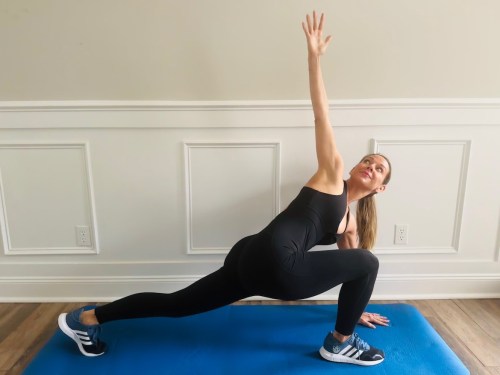
- 1.Start in the high plank position, with your hands shoulder-width apart and your legs straight behind you. Your body should be in a straight line.
- 2.Step your right foot forward so you are in a runner’s lunge position.
- 3.Keep your foot outside of your hands.
- 4.Twisting your torso, reach your right arm up toward the ceiling. Keep your left arm on the ground. You should be looking at your right hand.
- 5.Hold for 10 seconds.
- 6.Place both hands back on the ground and step your right leg back so you are in the plank starting position.
- 7.Step your left foot forward in a runner’s lunge, keeping your foot outside of your hands.
- 8.Twist and reach your left hand up toward the ceiling.
- 9.Hold 10 seconds.
- 10.Repeat 5 times on each side.
2. Hip 90-90 Stretch
The hip 90-90 stretch is a wonderful way to increase mobility in the hips, as it increases flexibility with both internal rotation and external rotation. It stretches all the muscles around your hip, including abductors, adductors, glutes, hip flexors, and piriformis.

- 1.Sit on the floor and bend one leg in front, with your knee at a 90-degree angle. Your knee and ankle should be resting on the ground.
- 2.Place your other leg to the side, bending that also to a 90-degree angle with that knee and ankle on the ground.
- 3.Both knees should be pointing in the same direction.
- 4.If your knees can’t comfortably rest on the ground, place a yoga block or rolled-up towel under the hip of your front leg to help assist.
- 5.Keep your back straight and your weight evenly distributed on both hips.
- 6.Hold for 60 seconds.
- 7.Rotate your legs the other way, so the leg that was in front is now in the back, and vice versa.
- 8.Hold for 60 seconds. Repeat for 2 to 5 reps on each side.
3. Pigeon Pose Stretch
This is a great stretch to do if you sit all day. “I love the pigeon stretch to develop hip flexibility and mobility,” says Peak. This hip-opening move stretches your hip flexors, glutes, piriformis, and groin.

- 1.Start in a downward dog position.
- 2.Lift your right leg up behind you toward the ceiling, and then move it forward until your right knee is bent in front.
- 3.While your right knee is bent in front, your left leg should be straight behind you.
- 4.The top of your left foot should be resting on the ground. Keep your pelvis straight ahead.
- 5.Keeping your spine straight and arms in front for support, hold this position for 30 to 60 seconds.
- 6.Bring your legs back into the downward dog position, and repeat the sequence on the other side.
- 7.Repeat 3 to 4 times on each side.
4. Piriformis Stretch
If you have sciatica or glute pain, the figure four stretch can help provide relief. This exercise stretches the piriformis muscle in your glute.
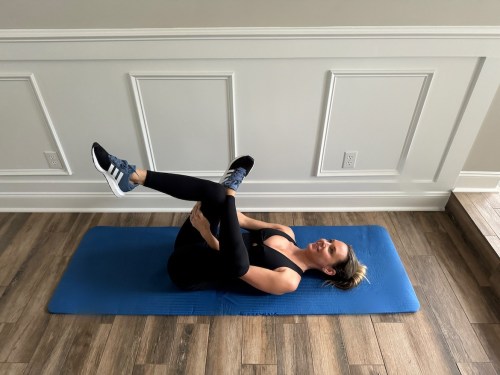
- 1.Lie on the floor with both knees bent and your feet flat on the floor.
- 2.Cross your leg so that the foot of one leg is resting on the knee of the other.
- 3.Grab your thigh (just under your knee) and pull your knees toward your chest, feeling a stretch in your buttock.
- 4.Hold for 30 seconds.
- 5.Repeat on the other side.
- 6.Repeat 3 to 5 times on each side.
5. Foldover Stretch
This leg stretch increases flexibility in your hamstrings, hips, and calves. It also provides a nice gentle stretch for your lower back.
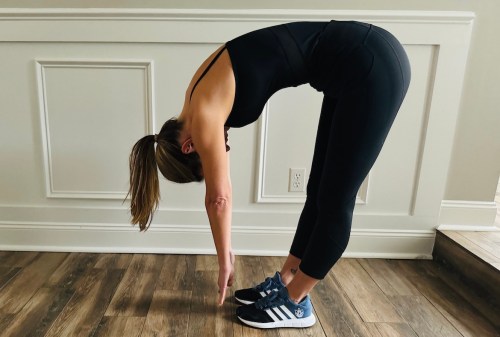
- 1.Stand with your feet hip-width apart and your hands at your sides.
- 2.Fold forward at your hips, as you reach towards the ground.
- 3.Your legs should be straight and your calves should stay on the ground.
- 4.Don’t lock your knees – it is okay if they have a slight bend.
- 5.Try to touch the floor with your fingertips. If you can’t touch the floor, bend your knees or use a yoga block under your hands until your flexibility improves.
- 6.Hold for 30-60 seconds.
- 7.Slowly roll back up to standing.
- 8.Repeat 3-5 times.
6. Standing Quad Stretch
This move stretches your quadriceps muscle, which is the large muscle at the front of your thigh.

- 1.Stand up straight, with one hand holding onto a chair or other stable surface for support.
- 2.Stand on your right foot and hold your left ankle or shin by bending your leg behind you.
- 3.Pull your bent leg into your glutes, focusing on keeping it straight and not twisting it.
- 4.You will feel a stretch along the front of your thigh.
- 5.Hold for 30 seconds.
- 6.Repeat on the other side.
- 7.Repeat 5 to 10 times on each side.
7. Toes On Wall Stretch
This stretch not only improves flexibility in your calf muscle but also the plantar fascia under your foot. This stretch is helpful if you have plantar fasciitis.
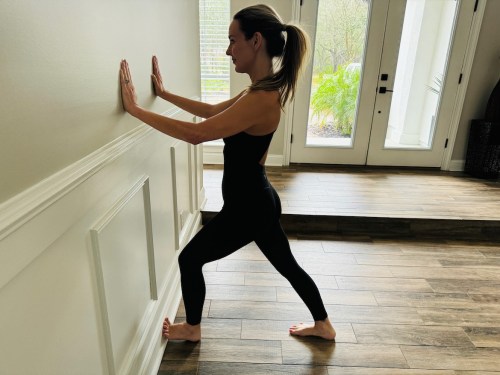
- 1.Stand and place your hands on the wall.
- 2.Place your right toes against the wall and your left leg back.
- 3.Keeping the heel of your left leg down, lean into the wall, feeling the stretch under your foot on your right side—and a stretch along the calf on your left leg.
- 4.Hold for 30 seconds.
- 5.Repeat on the other side.
- 6.Repeat 3 to 5 times on each side.
FAQ
What causes tight leg muscles?
Experts6 say that some people are just genetically predisposed to having tighter muscles than others. Other factors also play a role, including a sedentary lifestyle.
“Sitting down at the office for extended periods is a primary culprit of tight leg muscles,” says Peak. “Regular stretching and taking little walks in the day can help with this.”
Another factor is overuse or not warming up properly. “High-intensity workouts in the gym or at work can lead to tight legs. CrossFitters complain about this a fair bit due to the high-intensity, ‘squat-centric’ workouts,” says Peak.
When is the best time to stretch?
“It is beneficial to stretch both before your workout and after your workout,” says Mendez. “Dynamic stretching is best before a workout, while static stretching is best post-workout or during your cooldown.”
“Dynamic stretches are more activity-based movements to help reduce stiffness and improve speed and agility during your workout, whereas static stretching involves no movement and are performed holding a stretch for about 15 to 60 seconds,” she says.
Behm, David G et al. “Acute effects of muscle stretching on physical performance, range of motion, and injury incidence in healthy active individuals: a systematic review.” Applied physiology, nutrition, and metabolism = Physiologie appliquee, nutrition et metabolisme vol. 41,1 (2016): 1-11. doi:10.1139/apnm-2015-0235
↩︎Hotta, Kazuki et al. “Daily muscle stretching enhances blood flow, endothelial function, capillarity, vascular volume and connectivity in aged skeletal muscle.” The Journal of physiology vol. 596,10 (2018): 1903-1917. doi:10.1113/JP275459
↩︎Turci, Aline Mendonça, et al. “Self-administered stretching exercises are as effective as motor control exercises for people with chronic non-specific low back pain: A randomised trial.” Journal of Physiotherapy, vol. 69, no. 2, Apr. 2023, pp. 93–99, https://doi.org/10.1016/j.jphys.2023.02.016.
↩︎Lee, Ilseok, et al. “Hamstring stretching significantly changes the sitting biomechanics.” International Journal of Industrial Ergonomics, vol. 84, July 2021, p. 103163, https://doi.org/10.1016/j.ergon.2021.103163.
↩︎Montero-Marín, Jesús et al. “Efectividad de un programa de estiramientos sobre los niveles de ansiedad de los trabajadores de una plataforma logística: un estudio controlado aleatorizado” [Effectiveness of a stretching program on anxiety levels of workers in a logistic platform: a randomized controlled study]. Atencion primaria vol. 45,7 (2013): 376-83. doi:10.1016/j.aprim.2013.03.002
↩︎Maciejewska-Skrendo, Agnieszka et al. “Genetics of Muscle Stiffness, Muscle Elasticity and Explosive Strength.” Journal of human kinetics vol. 74 143-159. 31 Aug. 2020, doi:10.2478/hukin-2020-0027
↩︎
Sign Up for Our Daily Newsletter
Get all the latest in wellness, trends, food, fitness, beauty, and more delivered right to your inbox.
Got it, you've been added to our email list.
